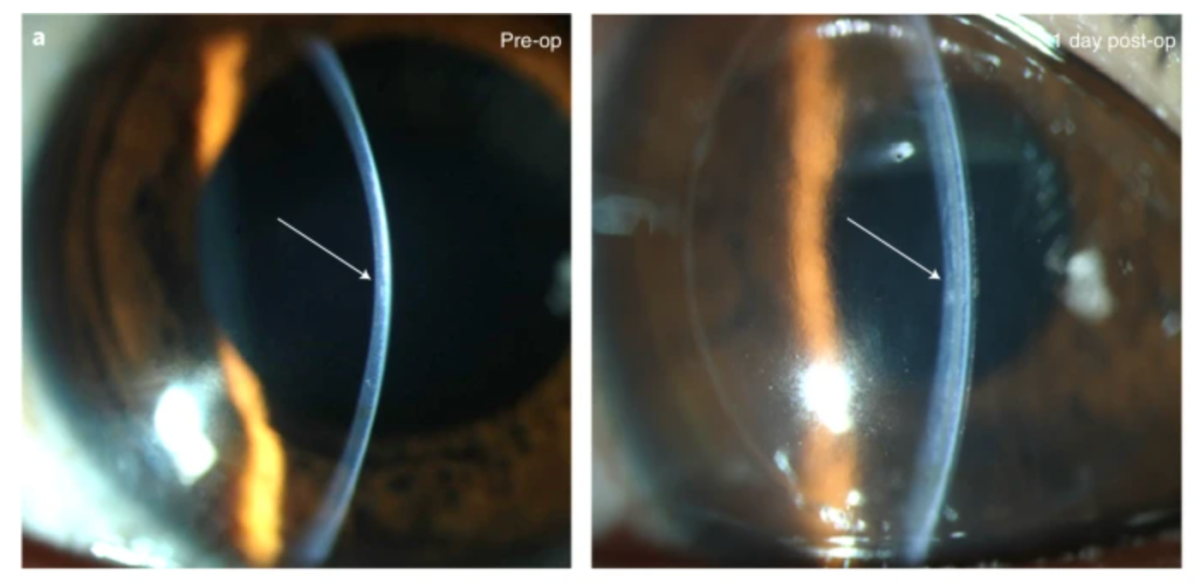Twenty people who were blind or suffered severe vision loss had some or all of their sight restored after researchers implanted bioengineered corneas into their eyes. This new technique may prove to have wide-ranging impacts across the globe because of the curious ingredient scientists used to create the corneal implants: pig skin.

Diseased corneas are a leading cause of blindness and a 2016 study found that an estimated 12.7 million people are on waiting lists to receive cornea transplants. A lack of human donors means that only one cornea is available for every 70 that are needed.
Researchers from Linköping University in Sweden and LinkoCare Life Sciences AB were looking to sidestep this problem and find an affordable solution to corneal blindness, which led them to develop a special implant made from medical-grade collagen from pig skin — a food industry byproduct that is relatively easy to source.
The findings of the years-long study were published on Thursday in Nature Biotechnology.
Scientists worked with 20 patients from Iran and India who all suffered from keratoconus, a condition that causes the cornea to thin and bulge outward. Fourteen of the patients were blind before they received the implant and all of them regained their vision after the procedure. Three of the previously blind people came out of the study with perfect vision.
To create the implant, the research team dissolved pig tissue to derive a purified collagen solution that was used to create a hydrogel. The hydrogel, which mimics the human cornea, was implanted into the existing cornea by surgeons in a minimally invasive procedure that involved making a small incision and didn’t require any stitches.
With human cornea transplants, doctors have to sew a new cornea into place which can cause healing complications to arise, according to the Mayo Clinic. This procedure also leaves patients open to the risk that their body will reject the transplant — which happens when the immune system attacks the foreign cells of the transplanted tissue.
Recipients of human cornea transplants must take immunosuppressive eye drops for more than a year, but the researchers found that recipients of pig skin transplants only needed to take immunosuppressive drugs for eight weeks.
Neil Lagali, a professor of experimental ophthalmology at Linköping University who co-authored the study, told NBC News that the risk of rejection for pig skin implants is low because the collagen does not contain any cells at all. Collagen is a protein made up of amino acids.
After monitoring the 20 patients for two years, the researchers found that none of the implants were rejected and no scarring or inflammation occurred.
For the Indian participants, the average visual acuity achieved with corrective lenses after receiving the implant was 20/26. For the Iranian participants, the visual acuity achieved was 20/58. The average acuity among the 14 initially blind participants was 20/36.
Perfect vision is defined as 20/20 and someone is considered legally blind with a visual acuity of 20/200.
Lagali and his team are excited at these positive results because pig skin implants provide a low-cost, widely available substitute to human cornea transplants, which are in short supply.
“Collagen from pig skin is a byproduct from the food industry,” he told NBC News. “This makes it broadly available and easier to procure.”
Lagali hopes to replicate the results of this study with a large group of 100 or more patients. Ultimately, they aim to get government approval for this procedure in order to make implants available in countries where human donations are scarce.
“We really designed this material and technology and surgical procedure to be adopted in areas of the world where there are really low resources,” Lagali said. “Those are the same areas of the world where the burden of blindness due to this disease is the highest.”







Comments